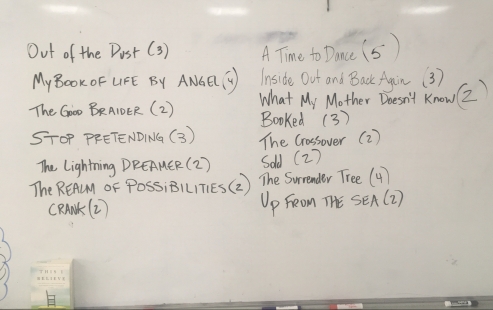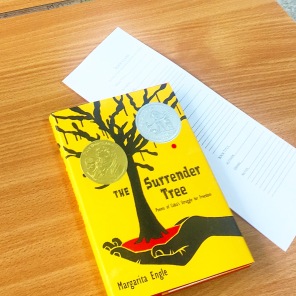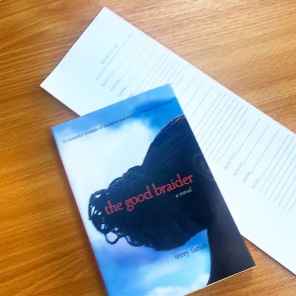Student voice and student choice have been the priority this school year as we try to foster healthy, robust reading lives in our students. They have been introduced to many titles through plenty of book talks and book recommendations, so they know there are a ton of choices out there for them, but this level of choice also means we haven’t had too many shared texts.
This spring I thought it might be fun to squeeze in some shared texts and build up our reading community with deliberate talk about books. I wanted us to be able to finish in just a couple of weeks, so we are engaging in book clubs with books written in verse.
In keeping with the priorities of student voice and student choice, I provided many titles for students to choose from as they entered into this short unit. These are all books that we have multiple copies of and can be found in our classroom libraries.
Before spring break my students were given a little time to get to know a book they hadn’t seen before, and then share that book with a partner. It took just a couple of minutes for each exchange, and then both partners switched books and started again. After a few rounds of sharing books, I allowed students to flip through the remaining titles that had seemed interesting but they hadn’t had the chance to hear about yet.
They had handouts for note-taking during this activity, and when we were done, they put the notes in their readers/writers notebooks so they would have easy access after the break.

When we returned from spring break, students reviewed their notes and listed their top five choices. I assigned and handed out the books, putting between two and four students in each group.

These are the titles students chose from.
The assignment was pretty straight-forward.
Students were directed to annotate for the fiction and/or nonfiction signposts found in Notice and Note and in Reading Nonfiction, (depending on their titles) the Book Head Heart framework and questions found in Disrupting Thinking, and some poetry vocabulary (listed below).
After they started reading, but before they were too many pages in, a few students had questions about how to annotate a book written in verse. They had annotated other texts before, but for some reason this type of text had some obstacles. 
I decided to do a quick, fun example of annotating a narrative poem with a simple children’s poem by Shel Silverstein. Cloony the Clown has many of the fiction signposts, poetic devices, and we talked about the Book Head Heart framework. Finding the signposts and annotating together was fun. It took less than fifteen minutes to share the example in class, and my students seemed much more comfortable with annotating their book club books when we were done with the activity.
Students then used their annotations to spark discussion, and regularly use them during the week to practice their sustained conversation.
They will be assessed next week in the form of a video-discussion, where they will meet in their book groups. Using iPads, they will record their thoughtful discussions, referring to annotations, making connections with the text, and sustaining academic conversation for around twenty minutes.
What I’ve heard and seen so far has been encouraging. Students are sharing, referring to lines and stanzas, and feel accomplished that they have read a complete text in such a short amount of time. Some of them are on their second or third-draft reading, which I think is a great strategy and habit to reinforce. They are truly getting to know their books, and in the process learning about story, poetry, and close reading.
Some students were able to read their book club book in an hour or two, and then get right back to their other choice reading. Others are encouraged by the progress they are quickly making in a full-length book because it often takes them longer than a few days to read most of a book. That’s one of the many great things about books written in verse – it doesn’t take a long time to read them, but they are rich with language, story, character, and they hold student interest. With the variety of types and titles, there really is something for everyone.
I borrowed an idea from this amazing post from Buffy J Hamilton regarding connecting text to the world around us. Next week, as one of the finishing activities in this short unit, students will each bring in a current event article which somehow relates to their books, and use these articles to launch new conversations about their books, connecting the text to themselves and to the world around us.
I’m pleased with the way these books clubs are progressing. My students don’t seem to feel intimidated by the length or weight of the books, and they tend to agree that the books are relevant and thought-provoking. While some of them have enjoyed books written in verse before their book clubs, for others this is one of their first experiences with a book written in verse. So for some students, this unit validates and supports their reading experience, and for others, it opens a door to a new form.
I encourage others to try some “unconventional” types of text for book clubs. Graphic novels, short stories, and poetry collections are all ideas I’m kicking around for future book club units, and I’m wondering how other teachers have incorporated different types of texts in their classes, and encouraged new conversation. Please leave your ideas and experiences in the comments below!
Julie has been teaching secondary language arts for nineteen years, spending the first fifteen in rural Central Oregon, and the last four in Amman, Jordan. She’s thrilled to report that she and her family will be moving across the agua to Managua, Nicaragua next year, where a new adventure will begin.
Follow her on twitter @SwinehartJulie














[…] purchased multiple copies of the same titles so I could organize book clubs and book partnership units and activities, and so some of my students can organically decide to […]
LikeLike
[…] purchased multiple copies of the same titles so I could organize book clubs and book partnership units and activities, and so some of my students can organically decide to […]
LikeLike
[…] completed a round of book clubs reading novels in verse (read more about these in Julie’s post). They devoured the books and loved talking about them together. As a summative assignment, the […]
LikeLike
[…] poetry. I learned to do more than have my students bring in their favorite song lyrics. I bought novels in verse and poetry anthologies. I read for pleasure. I wrote to discover, to wonder, to enjoy. I learned to […]
LikeLike
Love this post! So glad you wrote it. I’m so in love with novels in verse right now. Thanks for making me think about how to use them in our teaching!
LikeLike
Thank you so much for writing about this!!
Question: Where can I learn more about the “sign posts” that you highlight in this piece?
I’ve heard/read about them, but I’d like to know more.
LikeLike
Charles, Kylene Beers & Bob Probst book Notice & Note is the place to start to learn about signposts. They have one for fiction & one for non-fiction.
LikeLike